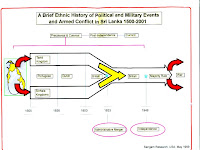A Brief Colonial History Of Ceylon(SriLanka)
Sri Lanka: One Island Two Nations
A Brief Colonial History Of Ceylon(SriLanka)
Sri Lanka: One Island Two Nations
(Full Story)
Search This Blog
Back to 500BC.
==========================
Thiranjala Weerasinghe sj.- One Island Two Nations
?????????????????????????????????????????????????Sunday, June 18, 2017
Search for 7 U.S. sailors missing off coast of Japan moves into second day
Seven U.S. sailors are missing after a U.S. Navy destroyer collided with a Philippine-flagged merchant ship off the coast of Japan on June 17. (Elyse Samuels/The Washington Post)
By Anna Fifield June 17 at 6:19 PM
TOKYO — The search for seven U.S. sailors missing off the coast of Japan continued into a second day Sunday, with U.S. and Japanese forces conducting air-and-sea patrols after a Navy destroyer collided with a much-larger container ship.
At the same time, civilian and military investigators tried to figure out how the nighttime collision between two vessels — both with advanced navigation systems — could have occurred.
“This has been a difficult day,” Vice Adm. Joseph P. Aucoin, the commander of the Seventh Fleet, said as the badly damaged USS Fitzgerald, an Aegis guided-missile destroyer, limped back into its home port at Yokosuka Naval Base, south of Tokyo, after emergency efforts at sea to control flooding.
Family members of the missing were waiting on the pier with Aucoin when it arrived, guided by two tug boats. The Seventh Fleet had set up an information center for the families, and had chaplains and a counselor on site.
The Fitzgerald collided with the Philippine-flagged Crystal, nearly four times its size, in a busy shipping lane south of Tokyo at 2:30 a.m. local time Saturday. The weather was clear with a swell of about six feet at the time.

Seven U.S. Navy sailors are missing off the coast of Japan after an Aegis guided-missile destroyer, the USS Fitzgerald, collided with a container ship, causing significant damage and flooding.
Three of the Fitzgerald’s crew, including the destroyer’s commanding officer, Cmdr. Bryce Benson, were evacuated from the damaged vessel and are being treated at the U.S. naval hospital at Yokosuka, the home of the U.S. Navy’s Seventh Fleet.
Benson was reported to be in stable condition, while the other two were treated for lacerations and bruises. All three were awake and being kept under observation in hospital, the Seventh Fleet said in a statement.
The Fitzgerald, an Arleigh Burke-class destroyer commissioned in 1995, is part of the Yokosuka-based group that includes the aircraft carrier USS Ronald Reagan, but it was operating independently of the carrier when the collision occurred, Cmdr. Ron Flanders, public affairs officer for U.S. Naval Forces in Japan, said.
When its crew is at full strength, the Fitzgerald usually has more than 250 personnel aboard and can reach speeds in excess of 30 knots.
The operators of the merchant ship, ACX Crystal, reported all of the 20-member Filipino crew were safe.
The Crystal, which was fully loaded with cargo, is bound for Tokyo, according to a website that tracks maritime traffic. It is operated by Nippon Yusen K.K., a Japanese shipping company, and was on its way from Nagoya port at the time of the collision.
“We are collaborating with the ship owner and fully cooperating with the investigation by the coast guard,” Nippon Yusen said in a statement.
All 20 Filipino crew members aboard the ship are safe and it has set up a
task force to deal with the accident, the company said, according to
the Kyodo News Agency.
Photos showed the container ship with minor damage to its bow, while the Fitzgerald appeared to have extensive damage midship on its right, or starboard, side, just below its bridge.
The destroyer was listing slightly, with water visibly being pumped, as it was towed into harbor.
Divers were waiting to inspect it below the waterline, where there had also been significant damage.
The collision had caused flooding in two berthing spaces, a machinery space and the radio room, the Seventh Fleet said.
“Thoughts and prayers with the sailors of USS Fitzgerald and their families,” President Trump wrote in a Twitter message Saturday. “Thank you to our Japanese allies for their assistance.”
The USS Dewey, another Navy destroyer, was helping with the search and rescue operations, along with three Japanese naval ships and two Japanese coastguard vessels. An American P-8 Poseidon aircraft was joined overhead by Japanese helicopters and an Orion aircraft.
There are extensive international guidelines for accident avoidance at sea known as the International Regulations for Preventing Collisions at Sea, or Colregs. The rules require that ships must have a watch posted at all times and follow a number of collision-avoidance steps when crossing paths with or overtaking other vessels.
Thomas Gibbons-Neff in Washington contributed to this report.
Seven U.S. sailors are missing after a U.S. Navy destroyer collided with a Philippine-flagged merchant ship off the coast of Japan on June 17. (Elyse Samuels/The Washington Post)
By Anna Fifield June 17 at 6:19 PM
TOKYO — The search for seven U.S. sailors missing off the coast of Japan continued into a second day Sunday, with U.S. and Japanese forces conducting air-and-sea patrols after a Navy destroyer collided with a much-larger container ship.
At the same time, civilian and military investigators tried to figure out how the nighttime collision between two vessels — both with advanced navigation systems — could have occurred.
“This has been a difficult day,” Vice Adm. Joseph P. Aucoin, the commander of the Seventh Fleet, said as the badly damaged USS Fitzgerald, an Aegis guided-missile destroyer, limped back into its home port at Yokosuka Naval Base, south of Tokyo, after emergency efforts at sea to control flooding.
Family members of the missing were waiting on the pier with Aucoin when it arrived, guided by two tug boats. The Seventh Fleet had set up an information center for the families, and had chaplains and a counselor on site.
The Fitzgerald collided with the Philippine-flagged Crystal, nearly four times its size, in a busy shipping lane south of Tokyo at 2:30 a.m. local time Saturday. The weather was clear with a swell of about six feet at the time.
Photos of the Navy destroyer USS Fitzgerald after collision with container ship

Seven U.S. Navy sailors are missing off the coast of Japan after an Aegis guided-missile destroyer, the USS Fitzgerald, collided with a container ship, causing significant damage and flooding.
Three of the Fitzgerald’s crew, including the destroyer’s commanding officer, Cmdr. Bryce Benson, were evacuated from the damaged vessel and are being treated at the U.S. naval hospital at Yokosuka, the home of the U.S. Navy’s Seventh Fleet.
Benson was reported to be in stable condition, while the other two were treated for lacerations and bruises. All three were awake and being kept under observation in hospital, the Seventh Fleet said in a statement.
The Fitzgerald, an Arleigh Burke-class destroyer commissioned in 1995, is part of the Yokosuka-based group that includes the aircraft carrier USS Ronald Reagan, but it was operating independently of the carrier when the collision occurred, Cmdr. Ron Flanders, public affairs officer for U.S. Naval Forces in Japan, said.
When its crew is at full strength, the Fitzgerald usually has more than 250 personnel aboard and can reach speeds in excess of 30 knots.
The operators of the merchant ship, ACX Crystal, reported all of the 20-member Filipino crew were safe.
The Crystal, which was fully loaded with cargo, is bound for Tokyo, according to a website that tracks maritime traffic. It is operated by Nippon Yusen K.K., a Japanese shipping company, and was on its way from Nagoya port at the time of the collision.
“We are collaborating with the ship owner and fully cooperating with the investigation by the coast guard,” Nippon Yusen said in a statement.
Photos showed the container ship with minor damage to its bow, while the Fitzgerald appeared to have extensive damage midship on its right, or starboard, side, just below its bridge.
The destroyer was listing slightly, with water visibly being pumped, as it was towed into harbor.
Divers were waiting to inspect it below the waterline, where there had also been significant damage.
The collision had caused flooding in two berthing spaces, a machinery space and the radio room, the Seventh Fleet said.
“Thoughts and prayers with the sailors of USS Fitzgerald and their families,” President Trump wrote in a Twitter message Saturday. “Thank you to our Japanese allies for their assistance.”
The USS Dewey, another Navy destroyer, was helping with the search and rescue operations, along with three Japanese naval ships and two Japanese coastguard vessels. An American P-8 Poseidon aircraft was joined overhead by Japanese helicopters and an Orion aircraft.
There are extensive international guidelines for accident avoidance at sea known as the International Regulations for Preventing Collisions at Sea, or Colregs. The rules require that ships must have a watch posted at all times and follow a number of collision-avoidance steps when crossing paths with or overtaking other vessels.
Thomas Gibbons-Neff in Washington contributed to this report.


